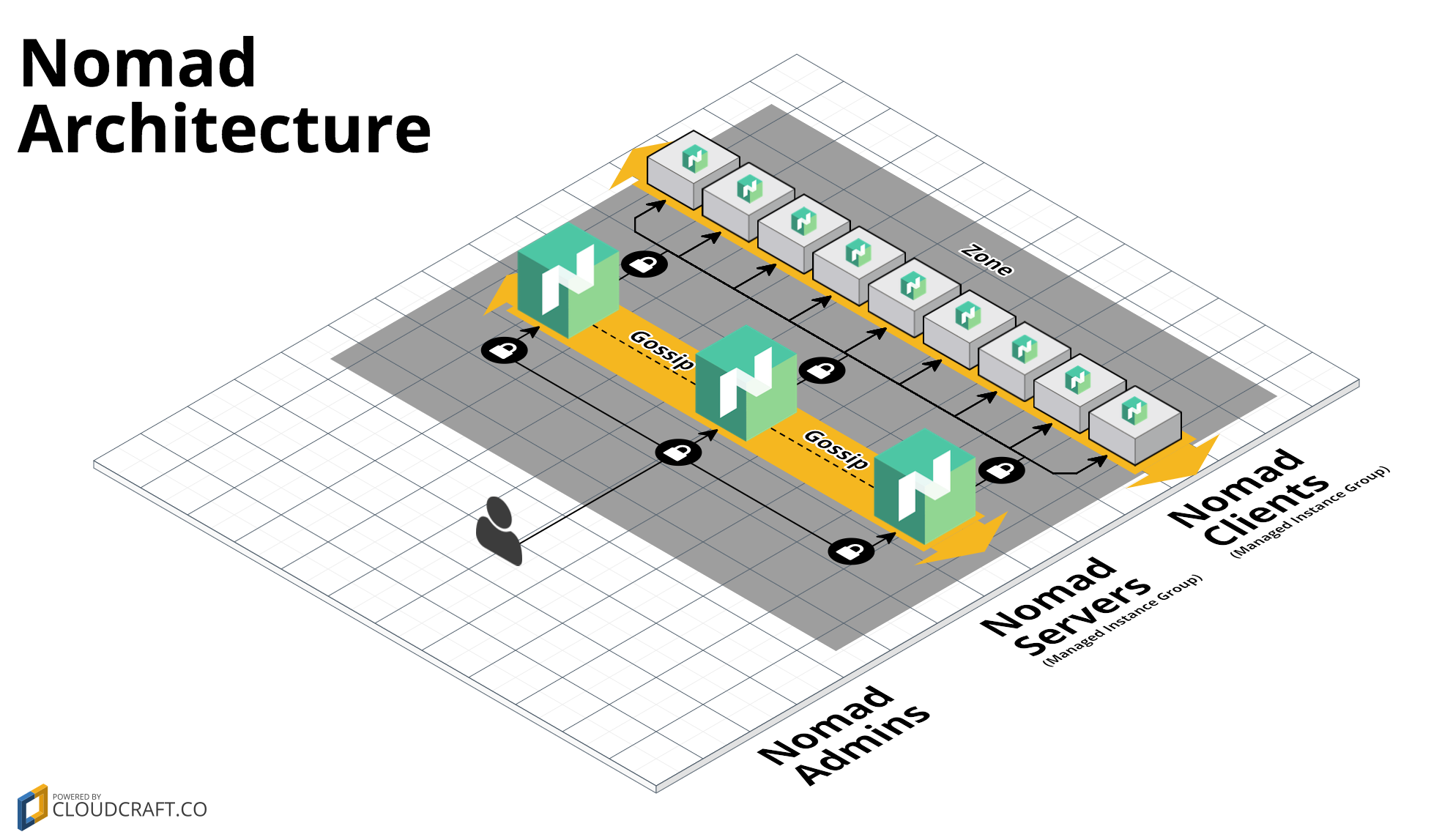Repo Browser: HashiCorp Nomad You need to enable JavaScript to run this app.
Gruntwork Website
HashiCorp Nomad Deploy a Nomad cluster. Supports automatic bootstrapping, discovery of Consul servers, automatic recovery of failed servers.
Nomad GCP Module
This repo contains a Module for how to deploy a Nomad cluster on Google Cloud using Terraform . Nomad is a distributed, highly-available
data-center aware scheduler. A Nomad cluster typically includes a small number of server nodes, which are responsible
for being part of the consensus protocol , and a larger
number of client nodes, which are used for running jobs:
This Module includes:
What's a Terraform Module?
A Terraform Module refers to a self-contained packages of Terraform configurations that are managed as a group. This repo
is a Terraform Module and contains many "submodules" which can be composed together to create useful infrastructure patterns.
Who maintains this Module?
This Module is maintained by Gruntwork . If you're looking for help or commercial
support, send an email to modules@gruntwork.io .
Gruntwork can help with:
Setup, customization, and support for this Module.
Modules for other types of infrastructure, such as VPCs, Docker clusters, databases, and continuous integration.
Modules that meet compliance requirements, such as HIPAA.
Consulting & Training on AWS, Google Cloud, Terraform, and DevOps.
How do you use this Module?
This Module has the following folder structure:
root : This folder shows an example of Terraform code
to deploy a Nomad cluster co-located with a Consul cluster
in Google Cloud modules : This folder contains the reusable
code for this Module, broken down into one or more submodules.examples : This folder contains examples of
how to use the submodules.test : Automated tests for the modules and examples.
To run a Nomad cluster, you need to deploy a small number of server nodes (typically 3), which are responsible
for being part of the consensus protocol , and a larger
number of client nodes, which are used for running jobs. You must also have a Consul cluster
deployed (see the Consul GCP Module ) in one of the following
configurations:
Deploy Nomad and Consul in the same cluster Deploy Nomad and Consul in separate clusters
Deploy Nomad and Consul in the same cluster
Use the install-consul module
from the Consul GCP Module and the install-nomad module from this Module in a Packer
template to create a Google Image with Consul and Nomad.
Ideally, we would publish a "public" image you can use for trail purposes, but Google Cloud does not yet support
custom public Images so, for now, you must build your own Google Image to use this module.
Deploy a small number of server nodes (typically, 3) using the consul-cluster
module . Execute the
run-consul script and the
run-nomad script on each node
during boot, setting the --server flag in both scripts.
Deploy as many client nodes as you need using the nomad-cluster module . Execute the run-consul script and the run-nomad script on each node during boot, setting the
--client flag in both scripts.
Check out the nomad-consul-colocated-cluster example
for working sample code.
Deploy Nomad and Consul in separate clusters
Deploy a standalone Consul cluster by following the instructions in the Consul GCP Module .
Use the scripts from the install-nomad module
in a Packer template to create a Google Image with Nomad installed.
Deploy a small number of server nodes (typically, 3) using the nomad-cluster module . Execute the run-nomad script on each node during boot, setting
the --server flag. You will need to configure each node with the connection details for your standalone Consul cluster.
Deploy as many client nodes as you need using the nomad-cluster module . Execute the run-nomad script on each node during boot, setting
the --client flag.
Check out the nomad-consul-separate-cluster example for working sample code.
How do I contribute to this Module?
Contributions are very welcome! Check out the Contribution Guidelines for instructions.
How is this Module versioned?
This Module follows the principles of Semantic Versioning . You can find each new release,
along with the changelog, in the Releases Page .
During initial development, the major version will be 0 (e.g., 0.x.y), which indicates the code does not yet have a
stable API. Once we hit 1.0.0, we will make every effort to maintain a backwards compatible API and use the MAJOR,
MINOR, and PATCH versions on each release to indicate any incompatibilities.
License
This code is released under the Apache 2.0 License. Please see LICENSE and NOTICE for more details.
Copyright © 2017 Gruntwork, Inc.
Questions? Ask away. We're here to talk about our services, answer any questions, give advice, or just to chat.
Ready to hand off the Gruntwork? "https://cdn.gruntwork.io/gruntwork-website/"
{"index":{"js":"https://cdn.gruntwork.io/gruntwork-website/index.bundle.c7884255553b53fbca3a.js","map":"https://cdn.gruntwork.io/gruntwork-website/index.bundle.1b14c1b7d19f1f5eb35d6e118e838255.map"},"styles":{"css":"https://cdn.gruntwork.io/gruntwork-website/styles.bundle.f22938926651ddec7c49.css","js":"https://cdn.gruntwork.io/gruntwork-website/styles.bundle.e782420e74a20dcb8691.js","map":"https://cdn.gruntwork.io/gruntwork-website/styles.bundle.d5e2af49807c6ca33f8367d621ece507.map"},"vendors":{"css":"https://cdn.gruntwork.io/gruntwork-website/vendors.bundle.29f7d0366a0978763f96.css","js":"https://cdn.gruntwork.io/gruntwork-website/vendors.bundle.fa8174a130797d75d12c.js","map":"https://cdn.gruntwork.io/gruntwork-website/vendors.bundle.57243d94deeeb29d5061288a338b4eb6.map"}}
{"treedata":{"name":"root","toggled":true,"children":[{"name":".circleci","children":[{"name":"config.yml","path":".circleci/config.yml","sha":"64b40b3f820ef642f31ee6cccef25fdee6980ba3"}]},{"name":".gitignore","path":".gitignore","sha":"2596dcea19a9e6032ff7a4156412bad370dad0ca"},{"name":"CODEOWNERS","path":"CODEOWNERS","sha":"4cd655694b6737b413e5f7b85a8158b0f5455e80"},{"name":"LICENSE","path":"LICENSE","sha":"7a4a3ea2424c09fbe48d455aed1eaa94d9124835"},{"name":"NOTICE","path":"NOTICE","sha":"114972fec7b7884cfdd51a0a3407eed39259238e"},{"name":"README.md","path":"README.md","sha":"30f9fe6afaf320ca60d4f6d3ab9d2317b81896a3","toggled":true},{"name":"_docs","children":[{"name":"architecture-colocated.png","path":"_docs/architecture-colocated.png","sha":"cf88c06565bff465b7f4e538a584b00d91618149"},{"name":"architecture-nomad-consul-separate.png","path":"_docs/architecture-nomad-consul-separate.png","sha":"884446de8d75f7ee26d78ae994318b2bdaad3180"},{"name":"architecture.png","path":"_docs/architecture.png","sha":"db14906c4884aa9afa483b20066f0a9430be00ff"}]},{"name":"examples","children":[{"name":"nomad-consul-image","children":[{"name":"README.md","path":"examples/nomad-consul-image/README.md","sha":"82feecb0fb3527276a3ce436e92e07c6174a1747"},{"name":"nomad-consul.json","path":"examples/nomad-consul-image/nomad-consul.json","sha":"11c91a187bf42a03498d3347d0bea72d20da7e69"}]},{"name":"nomad-consul-separate-cluster","children":[{"name":"README.md","path":"examples/nomad-consul-separate-cluster/README.md","sha":"39e8ec1375570dbedd1335acae652a039e08e123"},{"name":"main.tf","path":"examples/nomad-consul-separate-cluster/main.tf","sha":"e6f65f44981b117bbf4de31921851f421dfd6a29"},{"name":"outputs.tf","path":"examples/nomad-consul-separate-cluster/outputs.tf","sha":"2127cf690019a1302a773bb2970beb9e41b11ce6"},{"name":"startup-script-consul-server.sh","path":"examples/nomad-consul-separate-cluster/startup-script-consul-server.sh","sha":"4bc3646d0143b7e22a6b792a0509271b04d86552"},{"name":"startup-script-nomad-client.sh","path":"examples/nomad-consul-separate-cluster/startup-script-nomad-client.sh","sha":"4101d165cbcd2da994b274e9fc4cf7bd352a6104"},{"name":"startup-script-nomad-server.sh","path":"examples/nomad-consul-separate-cluster/startup-script-nomad-server.sh","sha":"6a8fc5e076b79548f604585fdd23ee550c8f88a3"},{"name":"variables.tf","path":"examples/nomad-consul-separate-cluster/variables.tf","sha":"6ee699651a80396af14ce6704515253a24ea41ba"}]},{"name":"nomad-examples-helper","children":[{"name":"README.md","path":"examples/nomad-examples-helper/README.md","sha":"4d9811b6aaaac01c43217de12273c3867def06ba"},{"name":"example.nomad","path":"examples/nomad-examples-helper/example.nomad","sha":"be74ce3c23bd52e9083294e0893d8966dc6208b5"},{"name":"nomad-examples-helper.sh","path":"examples/nomad-examples-helper/nomad-examples-helper.sh","sha":"039e8e76cbf449233265e6c35a51cff369d17092"}]},{"name":"root-example","children":[{"name":"README.md","path":"examples/root-example/README.md","sha":"43bc6364a09f88192073737ce02e32fac4c89a9b"},{"name":"startup-script-nomad-client.sh","path":"examples/root-example/startup-script-nomad-client.sh","sha":"293d3c54aceb07e804aa14b0a03fda1eb499701e"},{"name":"startup-script-nomad-consul-server.sh","path":"examples/root-example/startup-script-nomad-consul-server.sh","sha":"cff41e92d02485bac80282976a4a99ceb14d72ae"}]}]},{"name":"main.tf","path":"main.tf","sha":"9c47d1207f779ab7ade59a310af58c92b46df962"},{"name":"modules","children":[{"name":"install-nomad","children":[{"name":"README.md","path":"modules/install-nomad/README.md","sha":"685576c1b2a78ec24083bfe2e034968bdb8abd73"},{"name":"install-nomad","path":"modules/install-nomad/install-nomad","sha":"8d9fbcc7b9461a2cc896f047bdeed0f78c333951"},{"name":"supervisor-initd-script.sh","path":"modules/install-nomad/supervisor-initd-script.sh","sha":"171b91613e98ab2bd10282025caff1707918c95a"},{"name":"supervisord.conf","path":"modules/install-nomad/supervisord.conf","sha":"d96beb0ca9a16279ed1bdf74cbb6516275d85085"}]},{"name":"nomad-cluster","children":[{"name":"README.md","path":"modules/nomad-cluster/README.md","sha":"f9a36510aea762cb7638ac487c25e1f48b0881ac"},{"name":"main.tf","path":"modules/nomad-cluster/main.tf","sha":"248c39fc478c849c70d41c8e4333827b6f7b03df"},{"name":"outputs.tf","path":"modules/nomad-cluster/outputs.tf","sha":"4fb6f1b976287c0a67cf341004a3394815b6c0ee"},{"name":"variables.tf","path":"modules/nomad-cluster/variables.tf","sha":"1b56098eb0a52c18313539bffc99b230cda8b49c"}]},{"name":"nomad-firewall-rules","children":[{"name":"README.md","path":"modules/nomad-firewall-rules/README.md","sha":"c685a2cd7c1244439be31ed12aaa4f45f67ec4ef"},{"name":"main.tf","path":"modules/nomad-firewall-rules/main.tf","sha":"9ee7d8effa9947e6a0450a76ad9f3082a11f7368"},{"name":"outputs.tf","path":"modules/nomad-firewall-rules/outputs.tf","sha":"75f8ad0659a35676ee3ca58895e0ca0344a81c00"},{"name":"variables.tf","path":"modules/nomad-firewall-rules/variables.tf","sha":"553ef23926fdf00587cf2513dc24a9ebb8a5fc99"}]},{"name":"run-nomad","children":[{"name":"README.md","path":"modules/run-nomad/README.md","sha":"ebea3398672b0233c50090c9d6eb834da13ebe56"},{"name":"run-nomad","path":"modules/run-nomad/run-nomad","sha":"efb34945033226a049d9fe66e1707163ac52bb4e"}]}]},{"name":"outputs.tf","path":"outputs.tf","sha":"55ba87ed006fdec938f5bd33217774d6a64fe4b7"},{"name":"test","children":[{"name":"Gopkg.lock","path":"test/Gopkg.lock","sha":"25a35064c7cfb648ea3dcc91ecc3fe3f1868cf8f"},{"name":"Gopkg.toml","path":"test/Gopkg.toml","sha":"73f7e5a92632ee16a120f8a9312b6e3220761891"},{"name":"nomad_consul_separate_cluster_test.go","path":"test/nomad_consul_separate_cluster_test.go","sha":"ad043052f84a336c69add694a2cbef0c7f16e060"},{"name":"nomad_main_test.go","path":"test/nomad_main_test.go","sha":"623265a8f9cf3373bac06ffe67733e9eef3e3854"},{"name":"nomad_root_test.go","path":"test/nomad_root_test.go","sha":"f0b7bb1bc7a96b930b41b2ab1cab7d57aad749ea"},{"name":"nomad_test_helpers.go","path":"test/nomad_test_helpers.go","sha":"67752850820894defb5baf9a251b8c54f697d9f2"}]},{"name":"variables.tf","path":"variables.tf","sha":"23fb2c1c52a55c3a5b563276723a4bc17ac47540"}]},"detailsContent":"<p><a href=\"https://gruntwork.io/?ref=gcp_nomad_repo\" class=\"preview__body--description--blue\" target=\"_blank\"><img src=\"https://img.shields.io/badge/maintained%20by-gruntwork.io-%235849a6.svg\" alt=\"Maintained by Gruntwork.io\" class=\"preview__body--diagram\"></a></p>\n<h1 class=\"preview__body--title\" id=\"nomad-gcp-module\">Nomad GCP Module</h1><div class=\"preview__body--border\"></div><p>This repo contains a Module for how to deploy a <a href=\"https://www.nomadproject.io/\" class=\"preview__body--description--blue\" target=\"_blank\">Nomad</a> cluster on <a href=\"https://cloud.google.com/\" class=\"preview__body--description--blue\" target=\"_blank\">Google Cloud</a> using <a href=\"https://www.terraform.io/\" class=\"preview__body--description--blue\" target=\"_blank\">Terraform</a>. Nomad is a distributed, highly-available\ndata-center aware scheduler. A Nomad cluster typically includes a small number of server nodes, which are responsible\nfor being part of the <a href=\"https://www.nomadproject.io/docs/internals/consensus.html\" class=\"preview__body--description--blue\" target=\"_blank\">consensus protocol</a>, and a larger\nnumber of client nodes, which are used for running jobs:</p>\n<p><img src=\"https://github.com/hashicorp/terraform-google-nomad/blob/master/_docs/architecture.png?raw=true\" alt=\"Nomad architecture\" class=\"preview__body--diagram\"></p>\n<p>This Module includes:</p>\n<ul>\n<li>\n<p><a href=\"https://github.com/hashicorp/terraform-google-nomad/tree/master/modules/install-nomad\" class=\"preview__body--description--blue\" target=\"_blank\">install-nomad</a>: This module can\nbe used to install Nomad. It can be used in a <a href=\"https://www.packer.io/\" class=\"preview__body--description--blue\" target=\"_blank\">Packer</a> template to create a Nomad\n<a href=\"https://cloud.google.com/compute/docs/images\" class=\"preview__body--description--blue\" target=\"_blank\">Google Image</a>.</p>\n</li>\n<li>\n<p><a href=\"https://github.com/hashicorp/terraform-google-nomad/tree/master/modules/run-nomad\" class=\"preview__body--description--blue\" target=\"_blank\">run-nomad</a>: This module can be\nused to configure and run Nomad. It can be used in a <a href=\"https://cloud.google.com/compute/docs/startupscript\" class=\"preview__body--description--blue\" target=\"_blank\">Startup Script</a>\nscript to fire up Nomad while the server is booting.</p>\n</li>\n<li>\n<p><a href=\"https://github.com/hashicorp/terraform-google-nomad/tree/master/modules/nomad-cluster\" class=\"preview__body--description--blue\" target=\"_blank\">nomad-cluster</a>: Terraform code<br>\nto deploy a cluster of Nomad servers using a <a href=\"https://cloud.google.com/compute/docs/instance-groups/\" class=\"preview__body--description--blue\" target=\"_blank\">Managed Instance Group</a>.</p>\n</li>\n</ul>\n<h2 class=\"preview__body--subtitle\" id=\"whats-a-terraform-module\">What's a Terraform Module?</h2>\n<p>A Terraform Module refers to a self-contained packages of Terraform configurations that are managed as a group. This repo\nis a Terraform Module and contains many "submodules" which can be composed together to create useful infrastructure patterns.</p>\n<h2 class=\"preview__body--subtitle\" id=\"who-maintains-this-module\">Who maintains this Module?</h2>\n<p>This Module is maintained by <a href=\"http://www.gruntwork.io/\" class=\"preview__body--description--blue\" target=\"_blank\">Gruntwork</a>. If you're looking for help or commercial\nsupport, send an email to <a href=\"mailto:modules@gruntwork.io?Subject=Nomad%20Module\" class=\"preview__body--description--blue\" target=\"_blank\">modules@gruntwork.io</a>.\nGruntwork can help with:</p>\n<ul>\n<li>Setup, customization, and support for this Module.</li>\n<li>Modules for other types of infrastructure, such as VPCs, Docker clusters, databases, and continuous integration.</li>\n<li>Modules that meet compliance requirements, such as HIPAA.</li>\n<li>Consulting & Training on AWS, Google Cloud, Terraform, and DevOps.</li>\n</ul>\n<h2 class=\"preview__body--subtitle\" id=\"how-do-you-use-this-module\">How do you use this Module?</h2>\n<p>This Module has the following folder structure:</p>\n<ul>\n<li><a href=\"https://github.com/hashicorp/terraform-google-nomad/tree/master\" class=\"preview__body--description--blue\" target=\"_blank\">root</a>: This folder shows an example of Terraform code\nto deploy a <a href=\"https://www.nomadproject.io/\" class=\"preview__body--description--blue\" target=\"_blank\">Nomad</a> cluster co-located with a <a href=\"https://www.consul.io/\" class=\"preview__body--description--blue\" target=\"_blank\">Consul</a> cluster\nin <a href=\"https://cloud.google.com/\" class=\"preview__body--description--blue\" target=\"_blank\">Google Cloud</a></li>\n<li><a href=\"https://github.com/hashicorp/terraform-google-nomad/tree/master/modules\" class=\"preview__body--description--blue\" target=\"_blank\">modules</a>: This folder contains the reusable\ncode for this Module, broken down into one or more submodules.</li>\n<li><a href=\"https://github.com/hashicorp/terraform-google-nomad/tree/master/examples\" class=\"preview__body--description--blue\" target=\"_blank\">examples</a>: This folder contains examples of\nhow to use the submodules.</li>\n<li><a href=\"/repos/terraform-aws-nomad/test\" class=\"preview__body--description--blue\">test</a>: Automated tests for the modules and examples.</li>\n</ul>\n<p>To run a Nomad cluster, you need to deploy a small number of server nodes (typically 3), which are responsible\nfor being part of the <a href=\"https://www.nomadproject.io/docs/internals/consensus.html\" class=\"preview__body--description--blue\" target=\"_blank\">consensus protocol</a>, and a larger\nnumber of client nodes, which are used for running jobs. You must also have a <a href=\"https://www.consul.io/\" class=\"preview__body--description--blue\" target=\"_blank\">Consul</a> cluster\ndeployed (see the <a href=\"https://github.com/hashicorp/terraform-google-consul\" class=\"preview__body--description--blue\" target=\"_blank\">Consul GCP Module</a>) in one of the following\nconfigurations:</p>\n<ol>\n<li><a href=\"#deploy-nomad-and-consul-in-the-same-cluster\" class=\"preview__body--description--blue\">Deploy Nomad and Consul in the same cluster</a></li>\n<li><a href=\"#deploy-nomad-and-consul-in-separate-clusters\" class=\"preview__body--description--blue\">Deploy Nomad and Consul in separate clusters</a></li>\n</ol>\n<h3 class=\"preview__body--subtitle\" id=\"deploy-nomad-and-consul-in-the-same-cluster\">Deploy Nomad and Consul in the same cluster</h3>\n<ol>\n<li>\n<p>Use the <a href=\"https://github.com/hashicorp/terraform-google-consul/tree/master/modules/install-consul\" class=\"preview__body--description--blue\" target=\"_blank\">install-consul module</a>\nfrom the Consul GCP Module and the <a href=\"https://github.com/hashicorp/terraform-google-nomad/tree/master/modules/install-nomad\" class=\"preview__body--description--blue\" target=\"_blank\">install-nomad module</a> from this Module in a Packer\ntemplate to create a Google Image with Consul and Nomad.</p>\n<p>Ideally, we would publish a "public" image you can use for trail purposes, but Google Cloud does not yet support\ncustom public Images so, for now, you must build your own Google Image to use this module.</p>\n</li>\n<li>\n<p>Deploy a small number of server nodes (typically, 3) using the <a href=\"https://github.com/hashicorp/terraform-google-consul/tree/master/modules/consul-cluster\" class=\"preview__body--description--blue\" target=\"_blank\">consul-cluster\nmodule</a>. Execute the\n<a href=\"https://github.com/hashicorp/terraform-google-consul/tree/master/modules/run-consul\" class=\"preview__body--description--blue\" target=\"_blank\">run-consul script</a> and the\n<a href=\"https://github.com/hashicorp/terraform-google-nomad/tree/master/modules/run-nomad\" class=\"preview__body--description--blue\" target=\"_blank\">run-nomad script</a> on each node\nduring boot, setting the <code>--server</code> flag in both scripts.</p>\n</li>\n<li>\n<p>Deploy as many client nodes as you need using the <a href=\"https://github.com/hashicorp/terraform-google-nomad/tree/master/modules/nomad-cluster\" class=\"preview__body--description--blue\" target=\"_blank\">nomad-cluster module</a>. Execute the <a href=\"https://github.com/hashicorp/terraform-googe-consul/tree/master/modules/run-consul\" class=\"preview__body--description--blue\" target=\"_blank\">run-consul script</a> and the <a href=\"/repos/terraform-aws-nomad/modules/run-nomad\" class=\"preview__body--description--blue\">run-nomad script</a> on each node during boot, setting the\n<code>--client</code> flag in both scripts.</p>\n</li>\n</ol>\n<p>Check out the <a href=\"https://github.com/hashicorp/terraform-google-nomad/tree/master/examples/root-example\" class=\"preview__body--description--blue\" target=\"_blank\">nomad-consul-colocated-cluster example</a>\nfor working sample code.</p>\n<h3 class=\"preview__body--subtitle\" id=\"deploy-nomad-and-consul-in-separate-clusters\">Deploy Nomad and Consul in separate clusters</h3>\n<ol>\n<li>\n<p>Deploy a standalone Consul cluster by following the instructions in the <a href=\"https://github.com/hashicorp/terraform-google-consul\" class=\"preview__body--description--blue\" target=\"_blank\">Consul GCP Module</a>.</p>\n</li>\n<li>\n<p>Use the scripts from the <a href=\"https://github.com/hashicorp/terraform-google-nomad/tree/master/modules/install-nomad\" class=\"preview__body--description--blue\" target=\"_blank\">install-nomad module</a>\nin a Packer template to create a Google Image with Nomad installed.</p>\n</li>\n<li>\n<p>Deploy a small number of server nodes (typically, 3) using the <a href=\"https://github.com/hashicorp/terraform-google-nomad/tree/master/modules/nomad\" class=\"preview__body--description--blue\" target=\"_blank\">nomad-cluster module</a>. Execute the <a href=\"https://github.com/hashicorp/terraform-google-nomad/tree/master/modules/run-nomad\" class=\"preview__body--description--blue\" target=\"_blank\">run-nomad script</a> on each node during boot, setting\nthe <code>--server</code> flag. You will need to configure each node with the connection details for your standalone Consul cluster.</p>\n</li>\n<li>\n<p>Deploy as many client nodes as you need using the <a href=\"https://github.com/hashicorp/terraform-google-nomad/tree/master/modules/nomad\" class=\"preview__body--description--blue\" target=\"_blank\">nomad-cluster module</a>. Execute the <a href=\"https://github.com/hashicorp/terraform-google-nomad/tree/master/modules/run-nomad\" class=\"preview__body--description--blue\" target=\"_blank\">run-nomad script</a> on each node during boot, setting\nthe <code>--client</code> flag.</p>\n</li>\n</ol>\n<p>Check out the <a href=\"https://github.com/hashicorp/terraform-google-nomad/tree/master/examples/nomad-consul-separate-cluster\" class=\"preview__body--description--blue\" target=\"_blank\">nomad-consul-separate-cluster example</a> for working sample code.</p>\n<h2 class=\"preview__body--subtitle\" id=\"how-do-i-contribute-to-this-module\">How do I contribute to this Module?</h2>\n<p>Contributions are very welcome! Check out the <a href=\"https://github.com/hashicorp/terraform-google-nomad/tree/master/CONTRIBUTING.md\" class=\"preview__body--description--blue\" target=\"_blank\">Contribution Guidelines</a> for instructions.</p>\n<h2 class=\"preview__body--subtitle\" id=\"how-is-this-module-versioned\">How is this Module versioned?</h2>\n<p>This Module follows the principles of <a href=\"http://semver.org/\" class=\"preview__body--description--blue\" target=\"_blank\">Semantic Versioning</a>. You can find each new release,\nalong with the changelog, in the <a href=\"https://github.com/hashicorp/terraform-google-nomad/releases\" class=\"preview__body--description--blue\" target=\"_blank\">Releases Page</a>.</p>\n<p>During initial development, the major version will be 0 (e.g., <code>0.x.y</code>), which indicates the code does not yet have a\nstable API. Once we hit <code>1.0.0</code>, we will make every effort to maintain a backwards compatible API and use the MAJOR,\nMINOR, and PATCH versions on each release to indicate any incompatibilities.</p>\n<h2 class=\"preview__body--subtitle\" id=\"license\">License</h2>\n<p>This code is released under the Apache 2.0 License. Please see <a href=\"https://github.com/hashicorp/terraform-google-nomad/tree/master/LICENSE\" class=\"preview__body--description--blue\" target=\"_blank\">LICENSE</a> and <a href=\"/repos/terraform-aws-nomad/NOTICE\" class=\"preview__body--description--blue\">NOTICE</a> for more details.</p>\n<p>Copyright © 2017 Gruntwork, Inc.</p>\n","repoName":"terraform-google-nomad","repoRef":"v0.1.1","serviceDescriptor":{"serviceName":"HashiCorp Nomad","serviceRepoName":"terraform-google-nomad","serviceRepoOrg":"hashicorp","cloudProviders":["gcp"],"description":"Deploy a Nomad cluster. Supports automatic bootstrapping, discovery of Consul servers, automatic recovery of failed servers.","imageUrl":"nomad.png","licenseType":"open-source","technologies":["Terraform","Bash"],"compliance":[],"tags":[""]},"serviceCategoryName":"Docker orchestration","fileName":"README.md","filePath":"","title":"Repo Browser: HashiCorp Nomad","description":"Browse the repos in the Gruntwork Infrastructure as Code Library."}









